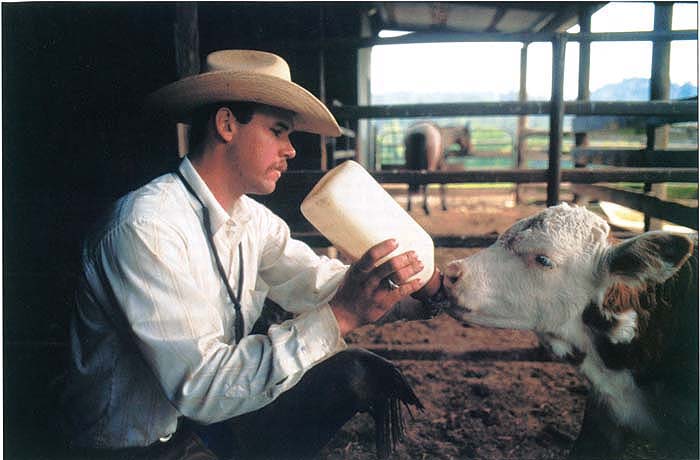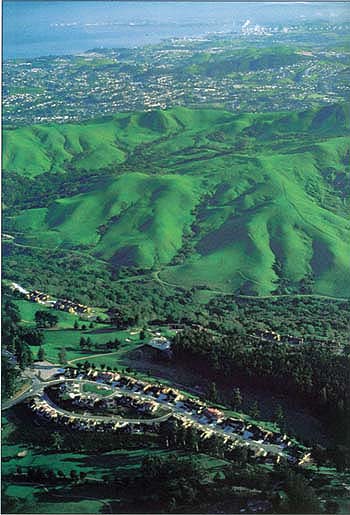All Issues
Comprehensive studies are needed: Food security, biodiversity threatened by population growth
Publication Information
California Agriculture 54(5):47-53. https://doi.org/10.3733/ca.v054n05p47
Published September 01, 2000
PDF | Citation | Permissions
Abstract
Major challenges confront agriculture and the rural environment as we begin the 21st century: providing for the nutritional needs of a growing human population, and sustaining natural resources for food production and biodiversity. Expanding the land area used for food production accelerates the loss of both animal and plant species, which, in turn, diminishes the genetic diversity available to increase food production. Over the last two centuries, nearly every continent has experienced a colossal loss of animal and plant species due to human intrusions. These losses are accelerating. Beyond the issue of providing adequate food are concerns that continued destruction of tropical forests — and species that survive only in these environments — will contribute to undesirable climatic changes, further complicating agricultural production and biodiversity. Extinction of tropical and other species reduces the world's genetic pool, including potential sources for greater food production and new medicines to improve animal and human health. Competing interests in California for land, water and capital could force agriculture out of California and into areas where the economy and culture are more favorable for food production. Can we assemble the necessary data to make critical decisions about the food systems before irreparable changes preclude reclaiming adequate resources for food production? Large, comprehensive studies are needed of defined agricultural areas, such as the Central Valley. Such studies would be multidisciplinary, long-term and expensive.
Full text
Until the 19th century, virtually the entire population was involved in food gathering or production. Today, the number of family farms, such as this ranch in Lotus, Calif., is steadily declining.
The large growth in human populations during the 20th century and projected growth rates for the 21st century will impact the food and environmental debate in a variety of ways (table 1). There is an ever-increasing need for a diverse and wholesome food supply to assure worldwide food security. At the same time, use of land and natural resources is expanding in a manner that contaminates resources needed for food production, such as soil, air and water. Ecosystems are being overused and destroyed to the point that they no longer sustain many plant and animal species. The effects of population growth, globalization and urbanization upon human, animal and environmental health and are increasingly recognized and studied by scientists (Goklany 1998; ISEH 1994; Gillespie 2000; Grant 2000).
Through technical innovations, we have expanded agricultural production during the past century to meet food needs. However, hunger remains a serious problem for approximately 800 million people worldwide (FAO 2000a; Arrow et al. 1995; Daily et al. 1998; Goklany 1998), due in part to limitations in food distribution to areas of need. Hunger can also be a result of political corruption, poor land policies and conservation practices, internal or regional wars, lack of transportation, absence of education systems and technological expertise, and depleted or inadequate soil and/or water to support agriculture. Due to urbanization, some nations are losing the expertise to produce food in rural areas. In other nations, urban sprawl is resulting in the loss of valuable land and water resources needed for food production (Daily et al. 1998; Frank 2000; United Nations 1996; Grant 2000).
Some argue that worldwide economic growth and technological innovations, such as agricultural biotechnology, will ensure future food security, along with an associated decrease in the rate of population growth (Goklany 1998; Merkel 1998; Holmes 1993). This view is contested by others who argue that new technology is not yet certain and emerging technologies may be harmful to the animal and plant biosphere (Alexander et al. 1999; Arrow et al. 1995; Krebs et al. 1999; Firbank et al. 2000; Watkinson et al. 2000).
Meanwhile, over the last two centuries, scientists estimate that species losses worldwide have been colossal, due in large part to human intrusions on animal and plant biospheres (Wilson 1992). While the exact number of extinct species is not known, these losses are accelerating (James et al. 2000; Wolf 1987). In 1987, Peter Raven, of the Missouri Botanical Gardens in St. Louis, warned that “more species of Earth's flora and fauna may disappear in our lifetime than were lost in the mass extinction that included the disappearance of the dinosaurs 65 million years ago.”
Beyond the issue of providing adequate food are concerns that continued destruction of tropical forests, and the immense number of species that can survive only in these environments, will contribute to undesirable climatic changes, further complicating agricultural production and biodiversity (Goklany 1998; McMichael and Martens 1995; Wolf 1987). Extinction of tropical and other species represents losses to the world gene pool, including potential sources for greater food production or new medicines to improve animal and human health. The destruction of tropical forests results in much greater losses of animal and plant species than compared with habitat-related losses in more temperate regions (Wolf 1987; James et al. 1999; Musters et al. 2000). Ethicists and moralists debate the right of humans to destroy plant and animal species, with some arguing that all species have a right to survive regardless of human need.
Competition for resources and views on how they are used locally and globally are at the center of the debate surrounding agriculture and food systems of the future (Goklany 1998; Somerville 1995; Tomsho 2000). Many complex and rapid changes have occurred in rural environments worldwide over the past two centuries (FAO 2000a; Goklany 1998; Wolf 1987). To appreciate the challenges confronting rural communities, it is important to comprehend these changes and their potential crippling effects on future food supplies.
Until the 19th century, nearly everyone was involved in food production or food gathering, and the distinctions between rural and urban life were negligible. Urban and rural residents shared an understanding of, and often an active interest in, the production and acquisition of food. In many developed nations during the last two centuries, technological innovations have enabled a small subset of the population to produce sufficient food to feed the entire population. With these changes, urban populations increased with a concurrent decrease in rural residents engaged in agriculture (Frank 2000; USDA 1999, United Nations 1996).
TABLE 1 World population projections for three growth-rate scenarios (low, medium and high growth rates)
A majority of the urban population in most nations lacks a detailed understanding of food systems and rural issues; most people have become detached from the production of their food.
Agriculture and human health
It is not enough to produce large quantities of food. With the global marketing of food, it is important to produce wholesome and nutritional food, in sufficient amounts to meet the world's needs. Also, the food must be safe and not cause illness (FAO 2000b; Gillespie 2000). The quality and safety of food requires taking appropriate management and hygienic steps on the farm. Systematic analysis of inputs and outputs in the farm environment can aid in defining critical points that affect food safety and quality.
Unfortunately, designing and implementing these procedures is often difficult in rapidly changing rural environments, where a wide array of production practices are required to meet the demands of specific environments. Almost everywhere, there is inadequate capital to institute major changes in production practices on farms or in local agricultural communities and there are no clear financial incentives for local farmers to improve practices for the long term. A food-safety production analysis done at a particular farm is rarely transferable to neighboring units because of differences in management and available capital (Daily 1998).
Land-use conflicts
In rural areas worldwide, nonagricultural development is occurring rapidly. Urban sprawl extends to transportation corridors, parking lots, air and train terminals, water transport systems, parks and recreation areas, wildlife preserves, greenbelts, industrial parks, electric power distribution systems, waste management facilities, educational campuses, public facilities, religious facilities and housing developments.
People living in rural areas are now frequently engaged in occupations unrelated to agriculture (Muirhead 1997). They move to rural areas to retire, raise families, develop home businesses, address health needs, satisfy esthetic desires and escape the perils of city life. Nonagricultural rural residents may have views and values that differ from those held by neighbors who work in agriculture (Muirhead 1997; Grant 2000).
In the 21st century, many people lack even basic knowledge about how food reaches the supermarket. Yet we expect our food to be plentiful, wholesome and safe.
In California, the conflicts over land use are as acute as in any developed area of the world. The conflict in California is particularly noteworthy because of the high agricultural productivity of several regions; the extraordinary population growth and urban sprawl; intense competition for resources such as capital, water, landspace, waste-disposal, chemicals, petroleum products and electricity; and diverse ecosystems including seashore, mountains and rich agricultural valleys (Ritter 2000).
In The End of Agriculture in the American Portfolio (1998), Steven Blank of UC Davis argues that competing interests in regions like California for land, water and capital will force agriculture into areas such as Europe, South and Central America and developing nations in Africa, where the economy and culture are more favorable. According to Hanson (1996), loss of small family farms in California's Central Valley has worldwide implications. He argues that displacing farmers from agricultural land anywhere increases the likelihood that the land will be used for nonagricultural purposes, and this is seen as a net loss to biodiversity and food production.
While Hanson's bleak economic analysis is not that different from Blank's (1998), he also describes a loss of “the agrarian idea” encompassing a set of values he sees as important to the broader society. Hanson argues that historically farmers have had fundamental values that enable them to confront first-hand the risks and challenges of raising food. These risks include variance in weather, ever-present pests and uncertainties of markets. He asserts these values stem from a simple commitment to producing food and a willingness to live in substantial uncertainty and often discomfort. These values are at odds with what he sees as a growing materialism in the larger society. His question is: If society doesn't respect these agriculturists' values and protect them, who will grow the food? Further, society would be well-served if there were a broader appreciation of the need to preserve human and natural resources to support food production.
As global population and habitat destruction increase, many plant and animal species have gone extinct or are on the verge of being lost forever. Certain species, such as the coyote, left, have adapted to urbanization, while others, such as the desert bighorn sheep, above, have not.
An emerging attitude among Californians toward stopping urban sprawl probably has little to do with their understanding of, or support for, preserving resources for food production and biodiversity (Sanchez 2000). Instead, it seems driven by their desire to stop changes that lessen access to green spaces, decrease wildlife habitat and decay, and cause parks and recreational areas to deteriorate. If sustained, these interests could form the core of coalitions working to change the environmental future of California, and if politically significant, resulting in sustaining resources for food production.
Food resources for the future
Most thoughtful people would agree we should strive to ensure sufficient food for future generations, which implies having the resources needed to produce food. However, there is far less agreement at international, national, regional or local levels on what will assure the future food supply.
Some economists argue that strong economies can provide resources to address wildlife preservation and food system needs, resources that are not available to poor communities or nations (Arrow et al. 1995; Daily et al. 1998; Goklany 1998; Holmes 1993; James et al. 2000). These “strong economy” proponents say the solution is to “do nothing to inhibit business enterprises that grow the economy” (Cornwall Declaration 2000).
If the global community is to address the serious loss of species that accompanies the destruction of tropical forests, many poor and tropical nations will need resources to survive and prosper without further destroying the forests now used for food production or other industrial uses. This would require a transfer of wealth from well-off economies to poorer nations, but this view is not universally accepted (Arrow et al. 1995; James et al. 2000; Musters et al. 2000).
Similarly, builders, developers and local governments are reluctant to pass on to new users the additional costs of preserving wildlife and natural resources, such as soil and water conservation. In fact, there is intense pressure to provide low-cost roadways and other transportation facilities to expanding urban areas, further complicating agroecosystems.
These debates are all the more difficult because in many instances, data illustrating the interconnectedness of wildlife, agriculture and the environment are sparse or incomplete (ISEH 1994). A case in point is the scientific and public-policy debate on how much land should be set aside to preserve species (Arrow et al. 1995; Holmes 1993; James et al. 1999; Musters et al. 2000). The likely answers are different for different species in different environments and regions.
Land needs vary with each species and may depend on which resources are available within a land area. Also, little is known about the relative risks of losing different species and future costs to society and world ecology if one species is lost as opposed to another (Wolf 1987). Because of these uncertainties, some scholars argue for taking the most conservative approach, which means preserving all remaining species of plants and animals (Wolf 1987; McNeill 2000).
Some endangered species have recovered under special management (e.g., sandhill cranes, bald eagle, grizzly bears), while other wildlife species have adapted well to urbanization and expanded their numbers (e.g., deer, raccoons, coyotes, several species of rodents and some species of birds). However, many of the animals that thrive in urban environments are also significant vectors of human and animal illness.
Wildlife as disease carriers.
As people further encroach on wildlife habitat, it is more likely that pathogens will be exchanged among wildlife, human beings and domestic animals. On the farm and elsewhere, wildlife can be vectors for spreading human diseases such as the West Nile virus, cholera, influenza, tuberculosis and rabies. Wildlife may also suffer from disease caused by organisms that are also human pathogens, such as rabies, tuberculosis and brucellosis (Daszak et al. 2000; Ferber 2000; Gillespie 2000). Some wildlife may carry human pathogens that do not make the animal ill, such as the foodborne pathogen Escherichia coli O157:H7 (Sargeant et al. 1999). Of great concern is the possibility that wildlife may carry new, foreign or emerging pathogens such as bovine spongiform encephalopathy (“mad cow disease”), rinderpest, cholera, influenza Marburg virus or the Ebola virus (Daszak et al. 2000).
We do not fully understand the risks and public-health implications of the changing relationships between human beings and wildlife. While we have some understanding of the dangers of wildlife carrying human pathogens, we do not know the potential dangers of emerging pathogens or foreign disease pathogens that wildlife may carry (Daszak et al. 2000). The latter is made even more elusive because intensive agricultural practices and urban sprawl force environmental change upon wildlife.
Future in focus: Large-scale studies needed
There is, however, broad consensus among developed nations that decisions regarding environmental, natural-resource and wildlife management should be science-based, and that choices for action should be made only after credible risk analysis and assessment.
The challenge then is to design and carry out scientifically sound studies that will yield answers and provide reliable and relevant data for risk assessment. We have advanced slowly with four types of studies: (1) basic studies designed to answer very specific biological questions; (2) narrowly defined studies of interactions among a few variables in the environment and an ecosystem, often in laboratory or controlled settings; (3) attempts to verify or examine the impact of various new innovations, techniques or practices that might impact the environment; and (4) observational studies in which data are collected on a specific set of variables in a limited geographical area.
While these studies have added to our knowledge, they leave large gaps and are often too narrowly defined to provide data that enables reliable risk analysis and decisions. From these diverse approaches, a question arises: Can we assemble the necessary data to make critical decisions about food systems before irreparable changes preclude reclaiming adequate resources for food production?
In addition to the smaller studies, large comprehensive studies of defined agricultural areas are needed. Such studies would be multidisciplinary, long-term and expensive. They would require large geographic areas (5,000 to 20,000 square miles, or 3.2 million to 12 million contiguous acres) in which a multitude of variables can be measured and their interrelationships defined. These would be of a scale and complexity beyond any previously undertaken, requiring a commitment from myriad scientific agencies, government agencies and the public, equal to or greater than that directed at the war on drugs or the search for cancer and AIDS cures.
The following steps must be taken, more or less in sequence, to enable the completion of the needed scientific studies.
Building political will.
The will to “do something about the environment” is growing in California and elsewhere (Sanchez 2000; Ritter 2000). Ideally, the majority of significant and influential political groups will share common views on the need and goals for scientific studies, and they will have an understanding of their complexity and cost. A significant effort will be required to inform and educate the public on complex issues.
Despite tremendous advances in agricultural production, hunger remains a serious problem for at least 800 million of the world's people. In Colombia, a 9-year-old boy suffers from malnutrition.
This will include acknowledging the absence of data needed to predict the future of food systems with and without environmental action and changes in current practices. Sustaining the public will, over the long-term course of the studies, will require constant feedback by scientists, community and national leaders, and public officials.
A major difficulty would be that individuals and groups may fear that winners and losers will emerge based upon actions taken because of the studies' findings. Uncertainty as to the outcome may weaken the public's resolve. Therefore, the focus must be on producing better scientific data for future decision-making. What those decisions will be, and who will decide, should be beyond the focus of the studies because that debate will distract from the coalition-building needed to fund and get them under way.
As people encroach on wildlife habitat, the likelihood increases that disease-causing pathogens will be exchanged among wildlife, humans and domestic animals.
Coalition building.
Exceptional leadership skills will be needed to build a coalition of scientists, governmental agencies, foundations, private agencies and others. Prolonged debate and planning could result in the loss of public interest and disengagement of coalition members. The coalition might function best if it is regionally defined to assure shared experiences, views and goals in the planning process. However, it is likely that the outcome of the studies will have worldwide implications.
Creating a focused theme.
This means defining scientifically sound practices that will harmonize the long-term needs of the environment, wildlife and the food systems. The goal should be to assure a food supply while sustaining healthy ecosystems for wildlife, other natural resources and future generations (ISEH 1994). The coalition should define sound practices so the public broadly understands them.
Designing long-term studies.
Two approaches could be used in the study design: (1) multidisciplinary study of current practices within an area and their impact on aspects of the environment, wildlife, human health, agricultural production and sustainability; (2) the impact of innovations, practices and technologies on long-term environmental health and agriculture.
These two approaches are not mutually exclusive. Multidisciplinary studies are needed to obtain input and interpretation of scientists and scholars from areas such as wildlife biology, ecology, environmental sciences, agriculture (soil, water, crop and animal sciences), economics, public health, epidemiology, global weather and geophysics, and veterinary medicine including animal health and food safety.
The interaction among these disciplines, beginning at the design phase of research and continuing through data interpretation, would likely lead to more sophisticated studies and thoughtful conclusions. In designing the studies, it is important not to underestimate the complexity and difficulty of field measurements and the control and definition of the multitude of interacting variables. In the real world, economic and other factors could lead to changes in practices or overall operations that seriously impact the design, conduct and interpretation of long-term studies.
The best designed research would have sophisticated, built-in, concurrent outcome-assessment systems, to measure the effects of each subset of variables and research phase. Ultimately, the study design and conduct should be under rigorous peer and shareholder review.
Identifying study sites.
There are compelling reasons to use large, in-operation rural areas for the studies. Small geographical areas have been shown to skew environment-wildlife interactions, and no doubt overlook important factors, such as multistate waterways, that affect a wide area and several aspects of the environmental dynamics of a region. It would be prudent to consider major regions like the Central Valley, or large portions of it, for study. Here the changes are rapid and dynamic, and if designed well, studies could capture a great deal of data on agricultural, environmental and human interaction within a decade, with results analyzed throughout the 10 years.
Acquiring long-term funding.
To be done well, these studies will be expensive, at least hundreds of millions of dollars. The results will have both local and worldwide implications. For that reason, it may be possible to garner funds from several nations, but this would require building public and political will across national borders, which is usually difficult. Under-funding or piecemeal funding would seriously compromise the studies by limiting the needed comprehensive, multidisciplinary approach (Raffensperger et al. 2000).
Nonetheless, the studies would not necessarily lead to responsible actions. Even with reliable risk assessments supporting decisions and actions, in most nations, political processes shape responses and actions. While one would expect society to be well-served in the end by actions to assure food security and biodiversity, short-term winners and losers are likely to emerge and exert political pressure during the decision-making process.
The opportunity exists to move from a high level of uncertainty about the future of food systems and the environment to one of greater certainty and ability to predict risks and interactions.
The United States has ample resources to do the science. Less certain is the political will to respond to the opportunity. Doing nothing may deprive society of the knowledge necessary to forestall complete failure of food systems and environmental resources needed for their recovery. Done well and soon, the proposed comprehensive studies would provide valuable models for achieving harmony between food production systems and the environment, and they would establish a model that other regions or nations can follow.











